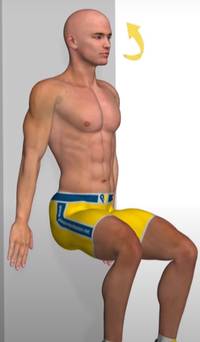The squat jump is a variation of the squat where you jump in the air. Do you want to know how to perform this exercise correctly, which muscles you train with it and what the best variations and alternatives are for the jump squat?
A squat jump, what is that exactly?
There are many different variations of squats. You can do this exercise with weights, without weights and you can also vary how deep you sink, the position of your legs and much more.
It is often thought that a squat jump means a box jump . However, this is not always the case.
In principle, every jumping variant of the squat is a squat jump. You will find the best variations of this exercise later in this article .
The perfect execution of the jump squat
Before we continue, I will first explain the correct basic execution of the jump squat.
Make sure you perform the exercise with the correct technique. This ensures greater effectiveness and prevents injuries.
The implementation goes as follows:
- Place both feet next to each other at shoulder width or slightly wider .
- Bend (slightly) by your knees. You don't have to drop to 90 degrees on the first jump .
- Jump up explosively .
- Land flat on both feet again and bend your knees to a 90 degree angle .
- Hold this position for a few seconds and then jump up strongly again .
What is it good for & which muscles do you train?
Why should you actually jump while squatting, are there any advantages to this?
You can think of, for example, sprinters and skaters, but footballers also benefit from the jump squat.
If you normally perform squats, you will have to exert less force, as both feet remain on the ground.
With the jumping variant you will have to get your entire body weight moving and let it come off the ground.
You will understand that this requires more of the leg muscles than keeping your feet flat on the floor.
Which muscles do you train with the jump squat?
The following muscle groups are involved in the performance of this exercise:
- Quadriceps
- Hamstrings
- Glutes
- Calves
- Abdominal muscles
What do you need for this exercise?
Good shoes are of course recommended and it is also nice to wear comfortable sportswear in which you have sufficient freedom of movement.
For example , a squat proof legging is recommended for women .
Also make sure that your pants are tight enough and that they cannot slip.
How do you make the exercise more challenging?
Have you mastered the execution of the squat jump well and would you like to make the exercise a bit heavier and / or more challenging?
It is always a good idea to expand on exercises and experiment with variations on them. This provides a new training stimulus and also makes the training a bit more fun.
Below you will find the best variations of the jump squat:
Box jumps

Box jumps are a very popular exercise among crossfitters. This is an exercise where you land on a platform. A so-called plyo box is almost always used for this.
These boxes are made of wood, but also made of softer materials. You can also obtain these in different heights.
However, as a beginner I advise you to use a soft plyo box , the soft version.
It can sometimes happen that you accidentally hit the box with your shins, and that is no fun. Many crossfitters will recognize this.
Jump squats with weight
In 'normal' squats you usually make the exercise heavier by adding weight. You might think that this will be a bit more difficult with the squats jump.
A barbell on your back during jump squats gets a bit trickier, but it is certainly possible.
However, I recommend holding a fitness ball to gain weight. These are much easier to hold. You can of course also do this exercise with dumbbells or kettlebells.
Note: Never perform the jump squats with weights that are too high. This is very bad for your knees and you can suffer from this in the long term.
If you want to use heavy weights, stick to the classic squat.
Jump higher
Another way to make the squat jump a bit heavier is to simply jump a little higher. The higher you jump, the heavier and the more effective the jump squat becomes.
The higher you get, the more power must be delivered from your legs.
If you want to know for yourself exactly how high you jump, you will have to come up with something creative for this, for example by placing an object next to it or having someone watch it.
Hold the squat position longer
How you can really get your leg muscles acidified is by performing squat jumps with the squat hold in between. In other words: after each jump you come back to the squat position and hold this position for a certain amount of time.
How long you hold the position is up to you. You will notice that the subsequent jumps will be a bit less smooth.
What are the best alternative exercises?
The jump squat is of course not the only good exercise for your leg muscles.
As you may know, I am a big fan of the squat, but below I will tell you a number of alternatives that do not include squat variants for a change:
Jumping lunges
Also a very good exercise for the explosiveness and comparable to the squat jump: the jumping lunges.
These, on the other hand, are slightly more effective for your core stability, as it will take you more effort to stay upright and maintain your balance.
Always start this exercise without weight and use your hands to maintain your balance. If you succeed, you can also make the jumping lunges heavier on yourself by adding weight, for example.
Wall sit

The wall sit is a completely different kind of exercise than the squat jump. In this exercise you stay in the squat position while keeping your back against the wall.
You will therefore rely less on your explosiveness, but on the other hand it is very good for your stamina.
In that respect it is a nice addition to the jump squats.
Tuck jumps
This may be a lesser known exercise, but it is certainly worth mentioning. Tuck jumps are similar to jump squats.
The only difference is that the goal is to jump as high as possible and try to bring your knees to the chest.
In this exercise, it is not recommended to hold weights, as you use your arms to jump as high as possible.
You can choose to do high knees (knee lifts) between each tuck jump .
Squat jump: Finally
Now that you have read my full explanation, you can crown yourself as a real squat jump expert.
You now know how to perform the exercise correctly, what the best variants are to make it heavier and you have also seen a number of good alternatives.
Do you have any questions about the squat jump? Ask it by leaving a comment below this article, or your question may already be answered below:
Ask about the jump squats
In which training forms are jump squats done?
The jump squat is a popular exercise in multiple sports and training forms. A number of sports in which this exercise is done are, for example:
- Crossfit
- Fitness
- Bootcamp
- Football
- Skate and
- Sprinting
Is this a safe exercise?
The squat jump is a safe exercise, provided you perform it of course using the correct technique . However, if you have problems with your knees, lower back, ankles or feet, it is better to leave the exercise for what it is, since the shock load is quite high.
Is it jump squat or squat jump?
If you've been paying close attention, I've used two types of names for the exercise in this article. You may have thought I made a mistake, but the truth is that the exercise can be called either a jump squat or a squat jump. Both names are therefore correct.








0 Comments